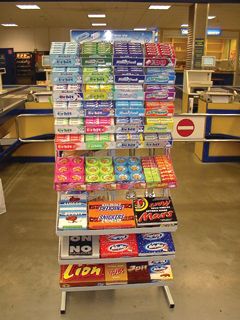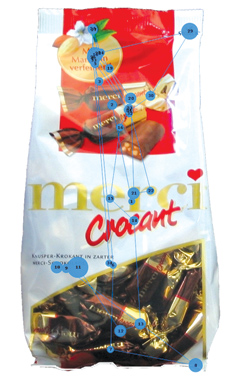- Research shows that more than two-thirds of purchase decisions are made at retail, as the shopper stands in front ing and merchandising play an important role in the impact on buying decisions, and the challenge is to communicate effectively during the short period of time a shopper is standing in front of a shelf browsing.
- Eye-tracking documents exactly what shoppers see and miss as they look at different categories. It clearly shows that shoppers tend to look only at parts of a shelf display, missing out on a lot of products—thus of the shelf. Each brand's packag-shelf browsing. immediately leaving them out of their relevant set for purchase. These unseen products are unsold, before even having a chance to convince shoppers.
Example 2
To understand the placement issue, our company, ProFakt, earlier this year tested the impact of the different shelves in a supermarket checkout situation (see Example 1). Given the importance of impulse sales, we wanted to better understand the ability of the different shelves on the rack to increase sales by making the most efficient use of the merchandising rack. By administering our Eye-Tracking methodology combined with verbal interviewing, we specifically wanted to find out about:
- The influence of shelf locationon overall attention and purchase likelihood.
- The optimal planogram designthat maximizes attention and increases the likelihood of purchase.
- The number of brands and vari-eties noticed on the rack.
Eye movements consist of fixations, during which the eye remains relatively still for about 200-300 milliseconds, separated by rapid movements, called saccades, which average three- to five-degrees in distance (measured in degrees of visual angle) and last 40 to 50 milliseconds. Eye-tracking equipment records the duration of each eye fixation and the exact coordinates of the fovea (the central two degrees of vision of the visual field) during the fixation with a frequency of 60 readings per second. It then maps the coordinates of the fovea to the location of each area of interest on the picture (e.g., brands on a supermarket shelf).

Example 1
The respondents in our test were simply asked to look at different shelf situations as they normally would while the Eye-Tracking technology recorded their viewing patterns and reported as one of the number of different measures available the percentage of subjects looking at the product or shelf area (i.e., making at least one eye fixation on the product). In the end we can show a gaze trail for every respondent that gives the exact location of the fixations and the time spent there (see Example 2).
RESULTS OF THE EYE-TRACKING TEST
Among adults the results clearly indicated that the bottom three shelves were the ones with the least attention-grabbing influence. The highest percentages (over 80 percent) were seen with the shelves in the middle of the gum section (shelf three and four from top to bottom) as well as the top candy shelf (shelf eight from the top).
With the kids it was a different story. While the top shelves were barely looked at, the highest percentages with kids were for shelves seven to nine (over 80 percent as well). The children also looked significantly longer than the adults, meaning a higher chance of communicating the brand's messages.
The results also showed that there is a higher visibility in the center and to the right than to the left of the rack, independent of the position of the shelf on the rack. There was also no difference in general between kids and adults. The viewing pattern indicated that adults usually start in the upper center of the rack (in the middle of shelf three or four) and go up and then down in a circle to the right, whereas kids do the same only in the lower parts of the rack.
IMPLICATIONS FOR MANUFACTURERS,RETAILERS
The results clearly indicate that in order to maximize profits, the main brands should be positioned in the center or to the right of each shelf. Depending on the target group (kids vs. adults) and the category, the closer the shelf is to eye level or above, the better it is. Further research is now under way to determine the influence of different package designs on the impact of sales revenues. Ideally, manufacturers want to get the package and the placement right to benefit most from their point-of-sale marketing.










